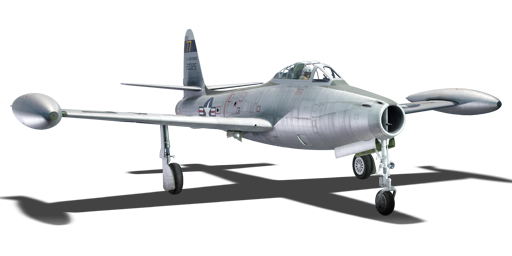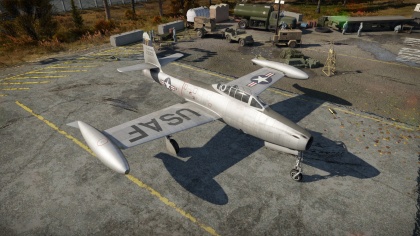F-84G-21-RE
Contents
| This page is about the aircraft F-84G-21-RE. For other uses, see F-84 (Family). |
Description
The F-84G-21-RE Thunderjet is a Rank V American jet fighter
with a battle rating of 7.7 (AB/RB) and 8.0 (SB). It was introduced in Update 1.77 "Advancing Storm".
General info
Flight Performance
| Characteristics | |||||||
|---|---|---|---|---|---|---|---|
| Stock | |||||||
| Max Speed (km/h at 0 m) |
Max altitude (meters) |
Turn time (seconds) |
Rate of climb (meters/second) |
Take-off run (meters) | |||
| AB | RB | AB | RB | AB | RB | ||
| 976 | 971 | 12500 | 28.9 | 30.5 | 30.1 | 29.5 | 1500 |
| Upgraded | |||||||
| Max Speed (km/h at 0 m) |
Max altitude (meters) | Turn time (seconds) | Rate of climb (meters/second) |
Take-off run (meters) | |||
| AB | RB | AB | RB | AB | RB | ||
| ? | ? | 12500 | ??.? | ??.? | ??.? | ??.? | 1500 |
Details
| Features | ||||
|---|---|---|---|---|
| Combat flap | Take-off flap | Landing flap | Air brakes | Arrestor gear |
| ✓ | ✓ | ✓ | ✓ | X |
| Limits | ||||
|---|---|---|---|---|
| Wing-break speed (km/h) |
Gear limit (km/h) |
Combat flap (km/h) |
Max Static G | |
| + | - | |||
| 1044.75 | 320 | 550 | ~?? | ~? |
| Optimal velocities | |||
|---|---|---|---|
| Ailerons (km/h) |
Rudder (km/h) |
Elevators (km/h) |
Radiator (km/h) |
| < 530 | < 600 | < 690 | N/A |
| Compressor (RB/SB) | ||
|---|---|---|
| Setting 1 | ||
| Optimal altitude | 100% Engine power | WEP Engine power |
| 0 m | 2300 kgf | No WEP |
Survivability and armour
- 38 mm Bulletproof glass in cockpit front.
- 6.35 mm Steel plate in front of pilot.
- 12.7 mm Steel plate in pilot's headrest.
- 8 mm Steel plate behind the pilot.
Armaments
Offensive armament
The F-84G-21-RE is armed with:
- 4 x 12.7 mm M3 Browning machine gun, nose-mounted (300 rpg = 1,200 total)
- 2 x 12.7 mm M3 Browning machine gun, wing-mounted (300 rpg = 600 total)
Suspended armament
The F-84G-21-RE can be outfitted with the following ordinance"
- Without load
- 2 x 100 lb AN-M30A1 bombs
- 2 x 250 lb AN-M57 bombs
- 2 x 500 lb AN-M64A1 bombs
- 2 x 1,000 lb AN-M65A1 bombs
- 24 x 127 mm HVAR rockets
- 32 x 127 mm HVAR rockets
- 24 x 127 mm HVAR rockets + 2 x 100 lb AN-M30A1 bombs
- 24 x 127 mm HVAR rockets + 2 x 250 lb AN-M57 bombs
- 24 x 127 mm HVAR rockets + 2 x 500 lb AN-M64A1 bombs
- 24 x 127 mm HVAR rockets + 2 x 1,000 lb AN-M65A1 bombs
- 24 x 127 mm HVAR rockets + 2 x 298 mm Tiny Tim rockets
Usage in battles
Describe the tactics of playing in an aircraft, the features of using vehicles in a team and advice on tactics. Refrain from creating a "guide" - do not impose a single point of view, but instead, give the reader food for thought. Examine the most dangerous enemies and give recommendations on fighting them. If necessary, note the specifics of the game in different modes (AB, RB, SB).
Modules
| Tier | Flight performance | Survivability | Weaponry | |||
|---|---|---|---|---|---|---|
| I | Fuselage Repair | Offensive 12 mm | FRC mk.7 | FSBC mk.1 | ||
| II | Compressor | Airframe | FSBC mk.5 | |||
| III | Wings Repair | Engine | New 12 mm MGs | FRC mk.7a | FMBC mk.1 | |
| IV | G-Suit | Cover | LFRC mk.12 | FLBC mk.1 | ||
Pros and cons
Pros:
- Respectable armament of six .50 cal machine guns with a great rate of fire
- Wide variety of payload options for striking ground targets
- Good acceleration
Cons:
- Turn rate is not very good, though better than the F-84B
History
In early 1944, Alexander Kartveli, the chief designer for the Republic Aviation Aircraft Company set out to work on a replacement for the piston-powered P-47 Thunderbolt which instead would be powered by a turbojet. All attempts at trying to use the P-47 frame to accommodate a turbojet failed and Kartveli resorted to designing a brand new aircraft around an axial compressor turbojet engine. Due to the nature of the engine taking up a large majority of the fuselage, fuel tanks were designed to be in the wings of the aircraft, however, the body was streamlined to make the smallest profile possible and retain all necessary critical components.
The USAAF in September 1944 released new requirements for a daytime fighter along with specific characteristics such as the top speed of 600 mph (966 kph), armament of six 21.7mm machine guns or four 15.2 mm machine guns along with housing a General Electric TG-180 axial turbojet also known as the Allison J35 series turbojet engine. Republic proposed their new aircraft and on paper proposed it would be superior to Lockheed’s P-80 Shooting Star. The USAAF noting Republic’s already proven experience with single-seat fighters proposed a contract without holding any competition. These initial order fighters were listed as YP-84As and P-84Bs.
These early test aircraft were put to wind tunnel testing and it was found that major flaws developed when subjected to high speeds, notably longitudinal instability in the aircraft’s frame and stabilizer skin buckling at high speeds. Also noted was issues with the weight of the aircraft and the problem with early turbojets not producing enough thrust for takeoff and climb outs (a problem which plagued the F-84B aircraft until more robust engines were outfitted). Early J35-GE-7 engines were replaced with J35-A-15 versions which helped with the thrust ratio, however wing-tip fuel tanks were added to the mix prior to proper testing and issues developed which at one point grounded the fleet of aircraft until modifications were made.
In 1947, the USAF changed the pursuit designation of the aircraft to fighter and thus the P-84 became the F-84. The YP-84A and the F-84B only differed when it came to the type of M3 machine guns they carried, as the F-84B had faster-firing machine guns than the YP-84A. Early successes of the F-84B were overshadowed by problem after problem including a speed restriction limiting flight to no more than Mach 0.8 as any faster and the aircraft experienced control reversal where the pilot would input normal commands with the control stick and the opposite manoeuvre would occur (for instance if the pilot pulled back on the control stick to make the aircraft climb, the aircraft would actually begin to dive and vice versa). Even with the speed restrictions, the entire fleet of F-84B fighters was grounded by 1948 due to parts shortages and structural failures. It was also at this time that the F-84C aircraft were also determined to be incapable of performing any of their mission parameters, however since the F-84D was already under production (with all of the B and C variants issues being resolved), the program continued. Funding was allocated to upgrade the B and C variants, however, both were finally withdrawn from active duty service by the end of 1952.
Testing of the F-84D determined that the wings needed to be covered with a thicker aluminium skin to strengthen them which was helpful because the engine was upgraded to the more powerful J35-A-17D. Here it was found that during high-G manoeuvres, the wingtip fuel tanks led to the structural failure of the wings due to twisting motions. A simple fix of adding a small triangular fin to the external portion of the fuel tank alleviated that problem. Despite the fixes introduced with the D variant, it too was withdrawn from active duty in 1952. The F-84E variant fighter saw modifications specifically with strengthened wings and a larger cockpit which was necessary to equip advanced avionics to include an A-1C gunsight which worked with an APG-30 radar. Folding rocket racks were also developed so that once the HVAR rockets were fired; the racks would fold flush with the wing increasing the aircraft’s overall aerodynamics. Unfortunately even with all of the modifications, failure of the aircraft hinged upon the Allison J35-A-17 engines which were only designed to be flown for 25 hours a month and would receive a complete overhaul after 100 hours of flight. Due to the number of sorties flown in the Korean War, engine overhauls were taking place more frequently and quickly exhausted all of the spare parts and new engines produced.
The final variant of F-84 introduced was the G variant which began service in 1951. Utilised for the next nine years, the F-84G had new innovations which became standard on future aircraft to include, a refuelling boom mounted on the left-wing for in-flight refuelling, instrument landing system to allow for landing during inclement weather, a J35-A-29 engine, an autopilot system and the first fighter with the ability to carry a single Mark 7 nuclear bomb. The F-84G was retired from US service in 1960, however, countries such as Portugal continued to use this fighter through 1974 and were flown out of Angola. The F-84 had a rocky start into the foray of turbine jet fighters, however, challenges and difficulties paved the way for the F-100 Super Sabre and the RF-101 Voodoo as their replacements.
Media
Excellent additions to the article would be video guides, screenshots from the game, and photos.
See also
Links to the articles on the War Thunder Wiki that you think will be useful for the reader, for example:
- reference to the series of the aircraft;
- links to approximate analogues of other nations and research trees.
External links
- Burrows, W. E. (2013, August). It had the body of a fighter and a bomber's soul. Retrieved from https://www.airspacemag.com/military-aviation/thunderjet-307269/
| USA jet aircraft | |
|---|---|
| Fighters | |
| F-4 | F-4C Phantom II · F-4E Phantom II · F-4J Phantom II · F-4S Phantom II |
| F-5 | F-5A · F-5C · F-5E · F-20A |
| F-8 | F8U-2 · F-8E |
| F-80 | F-80A-5 · F-80C-10 |
| F-84 | F-84B-26 · F-84F · F-84G-21-RE |
| F-86 | F-86A-5 · F-86F-25 · F-86F-2 · F-86F-35 |
| F-89 | F-89B · F-89D |
| F-100 | F-100D |
| F-104 | F-104A · F-104C |
| F-14 | F-14A Early · F-14B |
| F-15 | F-15A |
| F-16 | F-16A · F-16A ADF · F-16C |
| F9F | F9F-2 · F9F-5 · F9F-8 |
| Other | P-59A · F2H-2 · F3D-1 · F3H-2 · F4D-1 · F11F-1 |
| Strike Aircraft | |
| FJ-4 | FJ-4B · FJ-4B VMF-232 |
| A-4 | A-4B · A-4E Early |
| A-6 | A-6E TRAM |
| A-7 | A-7D · A-7E · A-7K |
| AV-8 | AV-8A · AV-8C |
| A-10 | A-10A · A-10A Late |
| B-57 | B-57A · B-57B |
| F-105 | F-105D |
| F-111 | F-111A |





